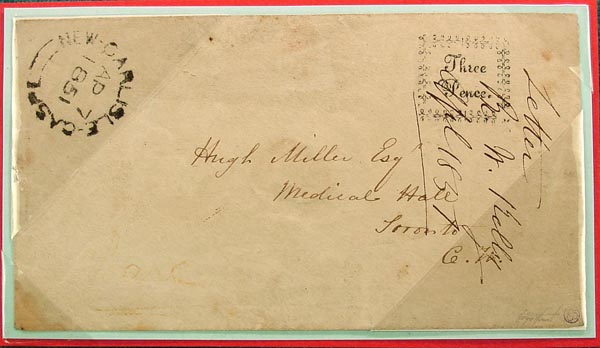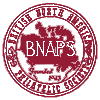An Extraordinary Canadian Cover
Norris (Bob) Dyer and Leopold Beaudet
(Bob Dyer wrote the original article in 2003. Leopold Beaudet updated it in 2013.)

Unique New Carlisle cover
Open your Stanley Gibbons catalogue to Canada. The first listing you'll see is "Postmaster's Provisional Envelope", #1, pictured above. Scott began listing it in 2004 in the Scott Classic Specialized Catalogue, where it was valued by the editor, James E. Kloetzel, at approximately US$250,000. This might make it the most valuable Canadian cover.
The cover has a unique "Three Pence" marking surrounded by a fancy border in the upper right corner. It is postmarked April 7, 1851, at New Carlisle-Gaspe and was mailed to Toronto. It is backstamped April 16 in Quebec. The sideways handwriting that partly obscures the "Three Pence" marking and the address reads:
Letter
R. W. Kelly [the postmaster of New Carlisle at the time]
April 1851
This notation is attributed to file docketing, probably by the recipient, Hugh Miller.
I was able to hold the cover (in its protective mounts) at WINEPEX 2003, San Rafael, California, on 5 October 2003. My club, the Redwood Empire Collectors Club, puts on this annual show. It was brought there by Sergio Sismondo, who was hired to be a caretaker for the cover and show it periodically at stamp exhibits. Its first venue was the WINEPEX show where he graciously let me examine it.
There is a short piece in the 2004 book, A.I.E.P. - Handbook of Philatelic Expertising, under "Sergio SISMONDO" [7]:
"Canada, 1851 issue: Cover from New Carlisle, Gaspe, to Toronto, dated 7 April 1851 and bearing the impression in black of a Postmaster's Provisional 3d stamp. The lines Letter / R.W. Kelly / April 1851, presumably a filing note by the recipient, were written across the stamp. Robert W. Kelly, the presumed sender of this Letter, was the postmaster of New Carlisle at the time. This is the only known copy of this Postmaster Provisional. Ex Ferrary and Burrus collections."
Sergio also wrote an updated two-page certificate of authenticity.
What a thrill it was to examine that cover! How many of us have been able to hold a unique philatelic rarity valued at $250,000?
The cover's provenance
The cover was first mentioned in the London Philatelist in June 1904 [2]. A Mr. E. B. Greenshields of Montreal had acquired it, and sent it to Donald A. King for his assessment. King was a prominent stamp dealer who traded under the name Emily King. He was also a postmaster of the Halifax post office. In his reply dated 22 February 1904, King said he had no doubt that the cover was genuine, and had never previously seen this marking.
The cover was sold to Count Philipp von Ferrary. He rubber-stamped it in the bottom right corner with his mark, a three-leaf clover in a circle. Before he died on 20 May 1917, he willed his collection to the Postmuseum in Berlin, but it was confiscated by the French government after World War I as war reparation. The collection was sold in 14 auctions in Paris between 1921 and 1926 [9]. The New Carlisle cover was sold in Ferrary Sale 3 in April 1922.
Maurice Burrus of Switzerland bought the New Carlisle cover, and kept it for some 40 years. Robson Lowe Ltd. sold it in a 2 April 1963 auction of Burrus BNA material [1]. The London Stamp Exchange (C. N. Richardson and D. M. Bolton) bought it for £275, and sold it in March 1964, almost a year later, to Stanley Gibbons for £525 [8]. Gibbons subsequently added the cover to the Canada listing in its catalogue.
The cover was in the "Consort" collection of Canada (owned by the jeweler Claude Cartier [3]), which was sold at a 24 November 1977 auction conducted by Stanley Gibbons Auctions Ltd. It was bought by K. M. Robertson Ltd. of Victoria, BC [8]. After spending over 70 years in Europe, this unique Canadian cover had returned to Canada.
In 2003, the then owner of the cover submitted it to the Vincent Graves Greene Philatelic Research Foundation for expertisation. The Foundation issued a report on its findings which was reprinted in the journals BNA Topics [5] and Fakes, Forgeries, Experts [6]. The report provides an analysis of the markings on the cover and describes its provenance. It includes the findings of a forensic document examiner that the Foundation had engaged to conduct a detailed examination.
In a 17 November 2010 auction in Geneva, Switzerland, David Feldman SA sold the cover as lot 60018 [3]. It realized €280,000 (about CA$390,000).
The controversy
This cover has generated considerable controversy, although its authenticity and provenance are not in dispute. As noted above, it has been listed in the Stanley Gibbons catalogue since 1964 and in the Scott Classic Specialized Catalogue since 2004. The primary issue is whether the "Three Pence" marking is a "prepaid provisional stamp" or just a "fancy rate marking".
On 10 August 1850, the Province of Canada passed The Post Office Act which transferred management of the "Inland Posts" from Britain to the Province effective 6 April 1851. The Act stipulated that, amongst other things [4, pp. 18-22]:
- Letters not exceeding one-half ounce in weight are liable to 3d postage
- Pre-payment of the postage is optional [in fact, payment upon receipt was prevalent at the time]
- Stamps for the pre-payment of postage were under preparation [Canada's first stamp, the 3d Beaver, was issued on 23 April 1851]
To prepare for the transfer, a notice detailing the Act's provisions was sent to postmasters from the General Post Office, Montreal, on 14 March 1851, three weeks before the Act was to come into effect [4, pp. 22-23]. The Postmaster General also issued a set of regulations to postmasters, among which were [4, p. 30]:
- If postage is paid when the letter is posted, the rate is to be marked in red ink and the word "PAID" is to be stamped or written against the postage rate
- If the postage is unpaid, the rate is to be marked in black ink
This was actually in force and carried out by postmasters well before The Post Office Act was passed. The New Carlisle cover is postmarked 7 April 1851, the day after the Act went into effect. The "Three Pence" marking is in black and there is no "PAID" marking.
In its 2003 report, the Vincent Graves Greene Philatelic Research Foundation concluded that the cover was genuine, but that the "Three Pence" was "nothing more than a nice example of a fancy rate marking" rather than a prepaid provisional stamp.
References
- The Burrus Collection British North America, Sale No. 2249-2250, 2 Apr. 1963, Robson Lowe Ltd., 1963.
- London Philatelist, Vol. XIII, June 1904.
- Rarities of the World (17 Nov. 2010 auction catalogue), David Feldman SA, 2010.
- Clifton A. Howes, Canadian Postage Stamps and Stationery, The New England Stamp Co., 1911. Reprinted by Quarterman Publications, Inc., 1974.
- Vincent Graves Greene Philatelic Research Foundation, "Shroud of New Carlisle, II", BNA Topics, Vol. 60, No. 4, Oct.-Dec. 2003.
- Vincent Graves Greene Philatelic Research Foundation, "New Carlisle Cover Analysis", Fakes, Forgeries, Experts, Vol. 7, May 2004.
- Wolfgang Hellrigl, editor, A.I.E.P. - Handbook of Philatelic Expertising, 2004.
- C. N. Richardson, "The Gaspé Postmaster's Provisional Cover - 1851", Canadian Philatelist, Vol. 30, No. 3, May-June 1979.
- Wikipedia, "Philipp von Ferrary", 28 Dec. 2012.
Copyright © 2003, 2013 Norris (Bob) Dyer and Leopold Beaudet.
Web design copyright © 2013-2026 The British North America Philatelic Society.
The documents on this website are for informational and non-commercial or personal use only.
Documents on this website shall not be used on other websites or for commercial purposes without permission.
This page was last modified on 2022-10-27
